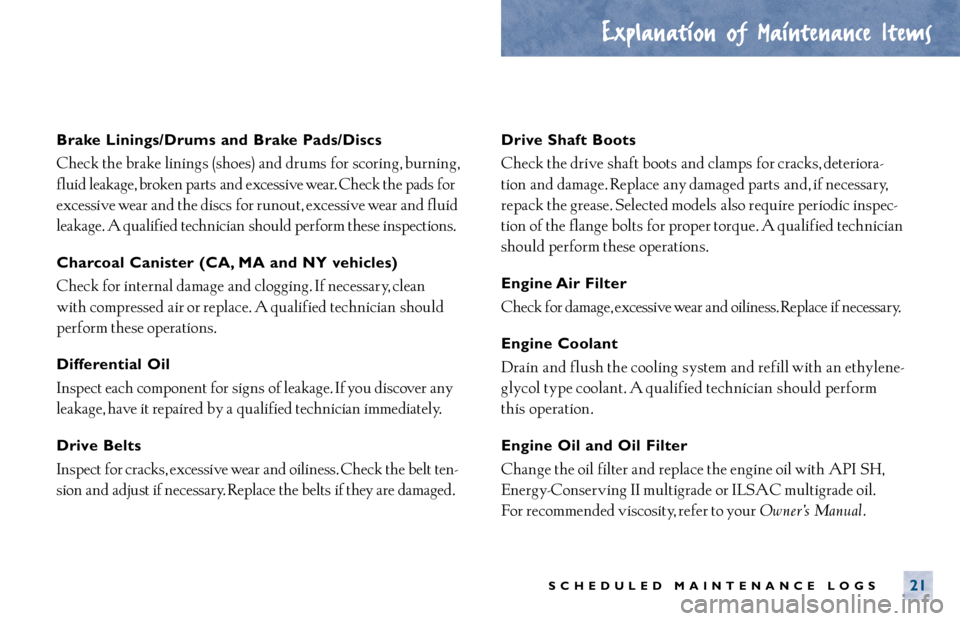Page 1021 of 4770

1
GENERAL 1999 FEATURES
156BE19
156BE20 156BE18
Occupant
Detection Sensor
Front Passenger Seat
Land CruiserSpacerElectrode Sheet
Electrode Sheet
Sensor OFF
Occupant
Sensor ON7
�SEAT BELT WARNING SYSTEM
1. General
A seat belt warning for the front passenger has been newly provided. When the front passenger seat is occu-
pied but its seat belt is not being worn, this function flashes a warning light to inform the front passenger that
the seat belt is not being worn.
2. Seat Belt Warning for Front Passenger
Construction
The seat belt warning for the front passenger consists of the front passenger seat belt buckle / retractor
switch, occupant detection sensor, seat belt warning light for the front passenger.
1) Belt Warning Occupant Detection Sensor
The occupant detection sensor, which is enclosed in the seat cushion of the front passenger seat, is used
to detect whether or not the front passenger seat is occupied.
This sensor, which is shaped as illustrated below, consists of a construction in which two sheets of elec-
trodes sandwich a spacer. When the occupant is seated, the electrode sheets come in contact with each
other through the hole that is provided in the spacer portion, thus enabling the current to flow.
Thus, the sensor detects whether or not an occupant is seated in the front passenger seat.
Page 1022 of 4770

GENERAL 1999 FEATURES
156BE14
Warning Light for
Front Passenger
Land Cruiser 8
2) Front Passenger Seat Belt Buckle / Retractor Switch
The front passenger seat belt buckle / retractor switch is enclosed in the seat belt buckle / retractor of the
front passenger seat to detect whether or not the seat belt for the front passenger is being worn.
3) Seat Belt Warning Light for Front Passenger
The seat belt warning light for front passenger flashes to warn if the front passenger does not have the
seat belt buckled.
Operation
When an occupant is seated in the front passenger seat, the occupant detection sensor activates, thus enab-
ling the system to recognize that the occupant has seated. When the ignition switch is turned ON, a warning
light flashes if the front passenger is not wearing the seat belt. The warning light continues to flash until
the front passenger wears the seat belt.
If the front passenger seat is not occupied, the warning light remains extinct regardless of the condition of
the seat belt.
Page 1027 of 4770

CAMRY ± OUTLINE OF NEW FEATURES
CAMRY
26
OUTLINE OF NEW FEATURES
The Camry is a high-quality family sedan with advanced technology and sporty performance. The following
changes are made for the 1999 model year.
1. Model Line-Up
�The following models have been added.
SXV20L-AEMDKK, SXV20L-AEPDKK
MCV20L-CEMNKA, MCV20L-AEPDKK
�The following models have been discontinued.
SXV20L-CEMDKK, SXV20L-CEPDKK, SXV20L-CEMNKK, SXV20L-CEPNKK
MCV20L-CEMDKA, MCV20L-CEPDKK, MCV20L-CEPGKK
2. Engine
�ORVR (On-board Refueling Vapor Recovery) system has been adopted on the 1MZ-FE engine models.
The basic construction and operation of this system are the same as in the '98 Camry with 5S-FE Engine.
�The direction of the rotation of the radiator cooling fan of the 1MZ-FE engine models has been reversed.
�A service port has been provided for inspecting the evaporative emission control system on all models.
For details, see the General 1999 Features section.
3. Axles
The rear axle bearing specifications have been partially changed.
4. Brakes
The brake specifications have been partially changed.
5. Body
�The attachment method for the front bumper reinforcement has been changed.
�The center pillar garnish extends into the vehicle's interior to provide its effectiveness in absorbing the
energy in case the occupant's head collides against the pillar.
�A reinforcement has been added to the rocker panel to effectively dissipate the impact energy during a
frontal collision, thus minimizing the deformation of the cabin.
�The front, center and rear pillar garnishes provide an impact-absorbing structure consisting of internal ribs
that dampen the impact.
6. Seat
A seat fabric has been changed on the CE grade models to improve the seat appearance.
7. Seat Belt
The shape of the tongue plate has been changed to help improve the usability of the seat belt.
Page 1065 of 4770

INTRODUCTION
INTRODUCTION Ð OUTLINE OF NEW FEATURES3
OUTLINE OF NEW FEATURES
An engine that is based on the 5S-FE engine, yet uses natural gas, has been developed in order to reduce
exhaust emissions and the amount of CO
2 discharge. A model that uses this alternative fuel engine has been
added to the Camry lineup. The characteristics of the new model are listed below.
1. Exterior
A CNG (Compressed Natural Gas) mark is affixed to the luggage compartment door.
2. 5S-FNE Engine
Based on the 5S-FE gasoline engine, the 5S-FNE engine uses compressed natural gas. The fuel lines have
been designed exclusively for compressed natural gas application.
3. A140E Automatic Transaxle
The gear ratio of the differential has been changed to accommodate the performance of the 5S-FNE engine.
4. Brakes
Basically, the same brakes used on the 5S-FE engine model are used on the CNG model, except that the
size of the front brakes has been changed.
5. Suspension
To accommodate the weight increase of the rear section of the vehicle as a result of having the fuel tank
installed in the luggage compartment, the specification of the springs used in the rear suspension has been
changed to realize excellent riding comfort, stability, and controllability.
6. Tire
P205/65 R 15 tire is used.
7. Body
�To install the fuel tank in the front area of the luggage compartment, the upper back panel has been
cut out.
�A performance rod that joins the tops of the right and left rear suspension strut towers has been adopted.
�The shape of the rear floor pan has been changed to prevent the luggage compartment capacity from
being reduced as a result of the installation of the fuel tank in the luggage compartment.
8. Seat
A fixed type seat back is used for the rear seat.
9. Seat Belt
2-point NR (Non-Retractor) seat belt is used for the rear center seat.
10. SRS Airbag
A signal that causes the supply of fuel to be cut off during a frontal collision is output by the airbag sensor
assembly to the ECM.
Page 1069 of 4770

NEW FEATURES Ð 5S-FNE ENGINE
NEW FEATURES
6
5S-FNE ENGINE
�DESCRIPTION
The 5S-FNE engine is a new engine that uses CNG (Compressed Natural Gas) as fuel, which has been
developed based on the 5S-FE gasoline engine.
The main component of natural gas is methane (CH
4), which has fewer carbons (C) than gasoline (mean
molecular formula: C
7.5H13.4). Therefore, the amount of CO2 discharged by this engine is approximately
70% that of the gasoline engine. Furthermore, this engine achieves low-emission operation by precisely
controlled air-fuel ratio and using special catalysts for the CNG application.
However, because the fuel is in the gaseous form, its volumetric efficiency is low, causing lower power
output if this fuel is used in the base engine.
Therefore, the 5S-FNE engine has adopted the following features: a high compression ratio, the intake
valves with early closed timing, the intake and exhaust valves with increased lift, a low back pressure muffler
made possible by the 2-way exhaust system, injectors for gaseous fuel, and a catalytic converter designed
exclusively for CNG application. At the same time, precision air-fuel ratio control is effected through the
use of the air-fuel ratio sensor* and the heater oxygen sensor, thus achieving the level of performance that
is equivalent to the base engine. Moreover, this engine realizes extremely low emissions and restoring engine
torque.
*: Already adopted on the California specification 5S-FE engine.
�Specifications �
Item
5S-FNE Engine5S-FE Engine
No. of Cyls. & Arrangement4-Cylinder, In-Line�
Valve Mechanism16-Valve DOHC,
Belt & Gear Drive�
Combustion CamberPentroof Type�
ManifoldsCross-Flow�
Fuel SystemSFI�
Displacement cm3 (cu. in.)2164 (132.0)�
Bore � Stroke mm (in.)87.0 � 91.0 (3.43 � 3.58)�
Compression Ratio11.0 : 19.5 : 1
Max. Output [SAE-NET]88 kW @ 5200 rpm
(118 HP @ 5200 rpm)
99 kW @ 5200 rpm
(133 HP @ 5200 rpm)
97 kW @ 5200 rpm*
(130 HP @ 5200 rpm)*
Max. Torque [SAE-NET]178 N´m @ 2400 rpm
(131 ft´lbf @ 2400 rpm)
199 N´m @ 4400 rpm
(147 ft´lbf @ 4400 rpm)
197 N´m @ 4400 rpm*
(145 ft´lbf @ 4400 rpm)*
IntakeOpen35 BTDC�
Valve
IntakeClose385 ABDC435 ABDCValve
Timing
ExhaustOpen455 BBDC�ExhaustClose35 AT D C�
Fuel Octane Number RON13091
Oil GradeAPI SJ EC or ILSAC�
*: California Specification Models
Page 1088 of 4770
NF
NEW FEATURES Ð SRS AIRBAD
Fuel Shutoff Valves
Front Airbag
Sensors
Airbag
Sensor
Assembly
AirbagsSeat Belt
Preten-
sionersFuel Cutoff
Signal
ECM
167CN19
SRS AIRBAG
�DESCRIPTION
When the SRS airbag is deployed, a signal to shut off the supply of fuel is output by the airbag sensor
assembly to the ECM.
�System Diagram �
Page 1113 of 4770

SCHEDULED MAINTENANCE LOGS21 Brake Linings/Drums and Brake Pads/Discs
Check the brake linings (shoes) and drums for scoring, burning,
fluid leakage, broken parts and excessive wear. Check the pads for
excessive wear and the discs for runout, excessive wear and fluid
leakage. A qualified technician should perform these inspections.
Charcoal Canister (CA, MA and NY vehicles)
Check for internal damage and clogging. If necessary, clean
with compressed air or replace. A qualified technician should
perform these operations.
Differential Oil
Inspect each component for signs of leakage. If you discover any
leakage, have it repaired by a qualified technician immediately.
Drive Belts
Inspect for cracks, excessive wear and oiliness. Check the belt ten-
sion and adjust if necessary. Replace the belts if they are damaged.
Drive Shaft Boots
Check the drive shaft boots and clamps for cracks, deteriora-
tion and damage. Replace any damaged parts and, if necessary,
repack the grease. Selected models also require periodic inspec-
tion of the flange bolts for proper torque. A qualified technician
should perform these operations.
Engine Air Filter
Check for damage, excessive wear and oiliness. Replace if necessary.
Engine Coolant
Drain and flush the cooling system and refill with an ethylene-
glycol type coolant. A qualified technician should perform
this operation.
Engine Oil and Oil Filter
Change the oil filter and replace the engine oil with API SH,
Energy- Conserving II multigrade or ILSAC multigrade oil.
For recommended viscosity, refer to your
Owner’s Manual.
Explanation of Maintenance Items
Page 1115 of 4770
Steering Linkage
With the vehicle stopped, check for excessive freeplay in the steer-
ing wheel. Inspect the linkage for bending and damage and the dust
boots for deterioration, cracks and damage. Replace any damaged
parts. A qualified technician should perform these operations.
Timing Belt
Replace every 90,000 miles. A qualified technician should per-
form this operation.
Tire Rotation
Tires should be rotated according to the instructions in the
Owner’s Manual. When rotating tires, check for damage and
uneven wear.
Transfer Case Oil
Inspect each component for signs of leakage. If you discover any
leakage, have it repaired by a qualified technician immediately.
Wheel Bearing and Drive Shaft Bushing Grease
Repack the wheel bearings with wheel bearing grease and the
front drive shaft bushings with molybdenum- disulfide lithium-
base chassis grease. A qualified technician should perform
these operations.
Explanation of Maintenance Items
SCHEDULED MAINTENANCE LOGS23